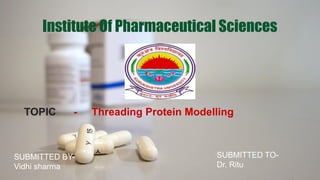
Protein Structure - threading Protein modelling pptx
- 1. Institute Of Pharmaceutical Sciences TOPIC - Threading Protein Modelling SUBMITTED BY- Vidhi sharma SUBMITTED TO- Dr. Ritu
- 2. Threading ● Threading = Placing or Aligning ● Protein threading is a bioinformatics technique used to predict the three-dimensional structure of a protein based on its amino acid sequence. The method involves threading, or aligning, the target protein sequence . ● Goal - is to identify the most energetically favorable or biologically relevant fold for a given protein sequence ● This computational approach helps bridge the gap between protein sequence and structure prediction, Placed into by force
- 4. Need of Threading ● Sequence of Homology<20 % ● Fold Recognition ● No 3D Structure Formality ● Computational Limitations
- 5. Protein Threading v/s Fold Recognition Protein Threading ● protein threading, the primary sequence of a target protein is compared against a database of known protein structures . ● The term "threading" refers to the process of aligning the target sequence onto the structures in the database, searching for the best fit or match. Fold Recognition: ● Fold recognition, also known as protein fold or structure prediction, involves identifying the structural fold or topology of a protein. ● Unlike threading, fold recognition methods don't necessarily rely on a fixed database of known structures.
- 6. History 1980s - Early Concepts: ● The foundations of protein threading can be linked to the early years of structural bioinformatics when researchers began exploring methods to predict protein structures computationally. 1990s - Threading Algorithms Emerge: ● In the early 1990s, threading algorithms started to gain prominence. These algorithms were designed to search for the best fit or alignment of a target protein sequence onto the structures in a protein structure database.
- 7. Principle Sequence-Structure Compatibility: ● Protein threading is based on the assumption that the native structure of a protein is related to its amino acid sequence. The method aims to find the best alignment or threading of the target sequence onto known protein structures. Template-Based Approach: ● Unlike homology modeling, where a close structural homolog is used as a template, protein threading does not necessarily rely on a one-to-one match. Statistical Potentials and Machine Learning: ● Protein threading methods often use statistical potentials or machine learning techniques to improve the accuracy of scoring functions.
- 8. Requirement ● Query sequence ● Library of core fold template ● Objective Function(evaluate any particular placement of sequence in a core template) ● Method of searching over space of alignment between sequence and each core of template ● Method of choosing the best template given alignment
- 9. Workflow
- 10. Sequence selection Sequence selection in the context of protein threading refers to the process of choosing a suitable target protein sequence for structure prediction. Fold Library A fold library, in the context of protein structure prediction, refers to a collection or database of representative protein folds or structural motifs. These libraries serve as valuable resources for computational methods such as protein threading and fold recognition
- 12. Threading ● Threading (also known as fold recognition or protein threading) is a technique used to predict the three-dimensional structure of a protein based on its amino acid sequence. ● This is important because knowing the structure of a protein helps in understanding its function, interactions with other molecules, and can be crucial for drug design and other applications. ● The threading method involves aligning the sequence of the target protein with known protein structures (templates) to predict the spatial arrangement of its amino acids. This process helps to identify potential structural similarities and infer the likely structure of the target protein.
- 14. Optimization Protein Structure Prediction Optimization: ● Threading and Homology Modeling: As mentioned earlier, threading methods and homology modeling are used to predict the three-dimensional structure of proteins. ● Optimization in these methods involves improving accuracy and efficiency, refining the energy functions used, and incorporating more accurate templates for modeling. In protein engineering, rational design involves modifying the amino acid sequence of a protein to enhance its properties or function. Optimization in this context aims to improve the protein stability, solubility, catalytic activity, or binding affinity.
- 15. Energy function , an energy function is a mathematical model used to assess the compatibility of a protein sequence with a given three-dimensional protein structure template. The energy function aims to quantify the fitness or similarity between the sequence of the target protein and the structural features of the template. A lower energy score indicates a better fit.
- 16. Solvent Accessibility ● Solvent accessibility refers to the extent to which a particular region of a protein structure is exposed or accessible to the surrounding solvent molecules, typically water. ● This concept is crucial in understanding the structure and function of proteins. ● Solvent accessibility information provides insights into the local environment of amino acid residues within a protein, influencing factors such as interactions with other molecules, stability, and the likelihood of being involved in binding sites Proteins are composed of amino acid residues, and these residues can be classified based on their solvent accessibility: Buried Residues: These are amino acid residues that are shielded from the solvent and located in the interior of the protein. Buried residues often contribute to the protein's core structure and stability. Exposed Residues: These residues are located on the surface of the protein and are directly accessible to the solvent. Exposed residues are more likely to interact with other molecules, such as other proteins, small ligands, or water molecules. ●
- 17. Branch and bound
- 18. How to Build Score Function ?
- 19. REFERENCES ● "Protein threading by PROSPECT: A prediction server and computational toolbox for structural genomics",Authors: Y. Xu, M. Madhavan, l. Shetty,. Li,Published in Bioinformatics, 2008 ○ ● GenTHREADER: an efficient and reliable protein fold recognition method for genomic sequences",Authors: O. S. Raghava, G. Barton,Published in Journal of Molecular Biology, 2001. ● https://www.slideshare.net/mohammedmuzammil31/threading-and-homology-modelling-methods